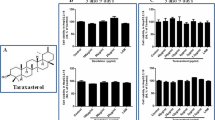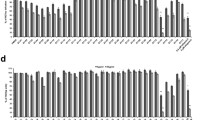Abstract
Hepatitis C virus is still a global challenge affecting millions of carriers worldwide with the more devastating situation in developing countries. Present-day clinical manifestations are insufficient to tackle the increasing disease burden unaffordable cost, viral resistance and adverse effects of treatment. In this research, indigenous medicinal plants from Pakistan tested in bioassay guided manner on Huh-7 cell lines for their antiviral effect, synergism of purified fraction with interferon FDA approved drug regime, as the receptor for developing transfection model. The methanol extract of Syzgium cumine was observed against HCV through serum titter reduction in Quantitative Real Time PCR assay and the gene expression system, NS3protease inhibition was 76% and 51% against genotype 1a and 3a, respectively. More precisely the most active fraction SC14 was assessed in dose response assay and synergistic potential resulted in 50% reduction (EC50 Value) in HCV titer of genotype 1a and 3a at a concentration of 71.96 ± 8.67 µg and 31.75 ± 3.28 µg, respectively, at a concentration of 100 µg. As per our research work, the S. cumine extract has shown a promising effect on HCV genotypes 1a and 3a. Moreover the purified fraction S. cumine SC14 has a potential synergistic effect and ability to suppress the gene effect of NS3 during transfection in Huh-7 cells and GC/MS analysis reports the presence of Di-n-octyl phthalate (C24H38O4) which can be future direct-acting antiviral therapy against Hepatitis C virus.






Similar content being viewed by others
References
Aly HH et al (2011) Development of mouse hepatocyte lines permissive for hepatitis C virus (HCV). PLoS ONE 6:e21284
Asselah T, Marcellin P (2011) New direct-acting antivirals’ combination for the treatment of chronic hepatitis C. Liver Int 31:68–77
Bellé LP et al (2013) Aqueous seed extract of Syzygium cumini inhibits the dipeptidyl peptidase IV and adenosine deaminase activities, but it does not change the CD26 expression in lymphocytes in vitro. J Physiol Biochem 69:119–124
Calland N, Dubuisson J, Rouillé Y, Séron K (2012) Hepatitis C virus and natural compounds: a new antiviral approach? Viruses 4:2197–2217
Deng H et al (2018) Naturally occurring antiviral drug resistance in HIV patients who are mono-infected or co-infected with HBV or HCV in China. J Med Virol 90:1246–1256
Ezhilarasan D, Apoorva VS, Ashok Vardhan N (2019) Syzygium cumini extract induced reactive oxygen species-mediated apoptosis in human oral squamous carcinoma cells. J Oral Pathol Med 48:115–121
Gu M, Rice CM (2013) Structures of hepatitis C virus nonstructural proteins required for replicase assembly and function. Curr Opin Virol 3(2):129–136
Haqqi A et al (2019) Prevalence of hepatitis C virus genotypes in Pakistan: current scenario and review of literature. Viral Immunol 32:402–413
Javed T, Ashfaq UA, Riaz S, Rehman S, Riazuddin S (2011) In-vitro antiviral activity of Solanum nigrum against Hepatitis C Virus. Virol J 8:1–7
Khaliq S, Raza SM (2018) Current status of direct acting antiviral agents against hepatitis C virus infection in Pakistan. Medicina 54:80
Mafirakureva N et al (2021) Cost-effectiveness of screening and treatment using direct-acting antivirals for chronic Hepatitis C virus in a primary care setting in Karachi, Pakistan. J Viral Hepatitis 28:268–278
Mohammed S, Harikumar K (2017) Cancer immunology of Syzygium cumini. In: Nair KN (ed) The genus syzygium. CRC Press, Taylor & Francis group, Milton Park, Abingdon-on-Thames, Oxfordshire, United Kingdom, pp 163–170. https://www.taylorfrancis.com/chapters/edit/10.1201/9781315118772-9/cancer-immunology-syzygium-cuminisabira-mohammed-harikumar
Moin A, Fatima H, Qadir TF (2018) Tackling hepatitis C—Pakistan’s road to success. Lancet 391:834–835
Nagamine T et al (2009) Inhibitory effect of fucoidan on Huh7 hepatoma cells through downregulation of CXCL12. Nutr Cancer 61:340–347
O’Neill LA, Bowie AG (2010) Sensing and signaling in antiviral innate immunity. Curr Biol 20:R328–R333
Omer S, Zakar R, Zakar MZ, Fischer F (2021) The influence of social and cultural practices on maternal mortality: a qualitative study from South Punjab, Pakistan. Reprod Health 18:1–12
Petruzziello A, Marigliano S, Loquercio G, Cozzolino A, Cacciapuoti C (2016) Global epidemiology of hepatitis C virus infection: an up-date of the distribution and circulation of hepatitis C virus genotypes. World J Gastroenterol 22:7824–7840
Rashid MA, Haque MR, Sikder MAA, Chowdhury AA, Rahman MS, Hasan CM (2014) Review on chemistry and bioactivities of secondary metabolites from some medicinal plants and microbes of Bangladesh. Bangl Pharm J 17:1–17
Rehman S, Ashfaq UA, Riaz S, Javed T, Riazuddin S (2011) Antiviral activity of Acacia nilotica against Hepatitis C Virus in liver infected cells. Virol J 8:1–6
Sheikh K, Ahmad T, Khan MA (2002) Use, exploitation and prospects for conservation: people and plant biodiversity of Naltar Valley, northwestern Karakorums, Pakistan. Biodivers Conserv 11:715–742
Süntar I (2020) Importance of ethnopharmacological studies in drug discovery: role of medicinal plants. Phytochem Rev 19:1199–1209
Yessuf AM (2015) Phytochemical extraction and screening of bio active compounds from black cumin (Nigella sativa) seeds extract. Am J Life Sci 3:358–364
Acknowledgements
The current study of research work of PhD has been submitted in Higher Education Commission (HEC) of Pakistan by the author. This research was supported by Higher Education Commission, Pakistan.
Author information
Authors and Affiliations
Contributions
TJ and HK designed the research, carried out most of the experiments MA and KA performed RNA extraction and Real Time PCR and collected HCV samples, SA wrote the manuscript and discussed with all the co-authors.
Corresponding author
Ethics declarations
Conflict of interest
All authors declare that they have no conflict of interest.
Additional information
Communicated by Ran Wang.
Publisher's Note
Springer Nature remains neutral with regard to jurisdictional claims in published maps and institutional affiliations.
Supplementary Information
Below is the link to the electronic supplementary material.
Rights and permissions
About this article
Cite this article
Riaz, S., Tiwana, H., Adil, M. et al. Anti-hepatitis C virus and synergistic potential of Syzgium cumine a bioassay guided screening in liver-infected hepatocytes. Arch Microbiol 204, 69 (2022). https://doi.org/10.1007/s00203-021-02646-3
Received:
Revised:
Accepted:
Published:
DOI: https://doi.org/10.1007/s00203-021-02646-3




